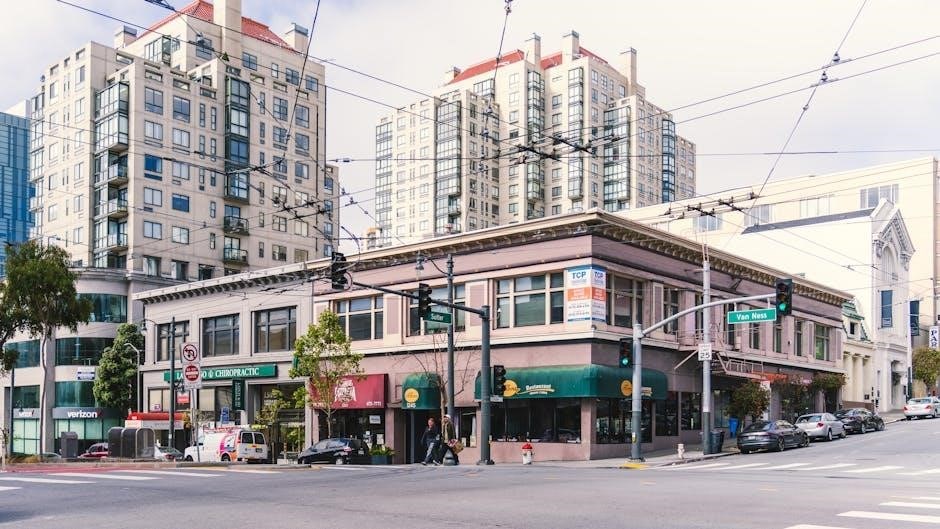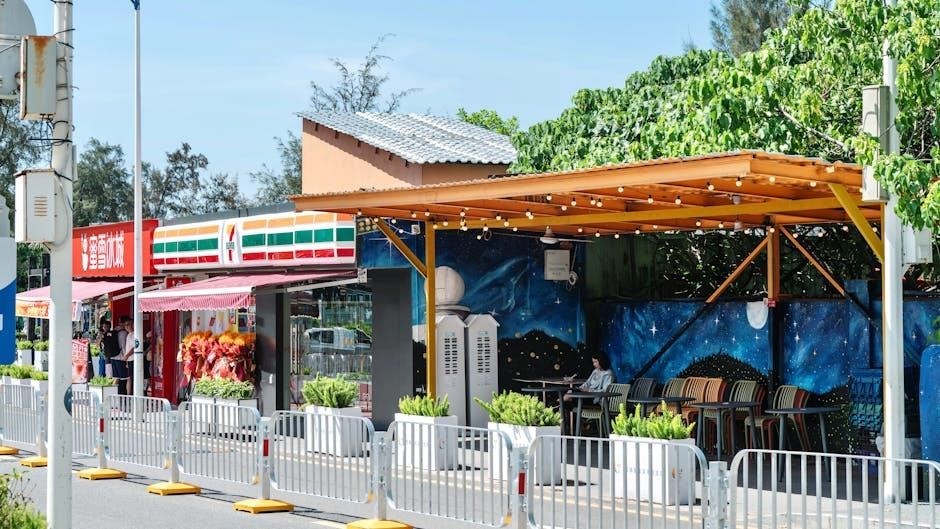The retail industry is undergoing a transformative shift‚ driven by technological advancements and evolving consumer expectations. Redefining Retail: 10 Guiding Principles for a Post-Digital World explores this evolution‚ offering insights into how retailers can adapt to remain relevant. By focusing on invisibility‚ indispensability‚ and intimacy‚ the book provides a roadmap for creating seamless‚ customer-centric experiences in a rapidly changing landscape.
Overview of the Book “Redefining Retail: 10 Guiding Principles for a Post-Digital World”
Redefining Retail: 10 Guiding Principles for a Post-Digital World is a groundbreaking book by renowned experts Philip Kotler and Giuseppe Stigliano‚ published in January 2024 by Wiley. This insightful guide explores the retail industry’s transformation in the post-digital era‚ offering practical strategies for businesses to thrive. The book introduces three core principles: invisibility‚ indispensability‚ and intimacy‚ which serve as the foundation for reimagining retail experiences. It provides actionable techniques for retailers to adapt to changing consumer behaviors‚ technological advancements‚ and sustainability demands. With a focus on innovation and customer-centric solutions‚ the book is a must-read for industry leaders seeking to navigate the evolving retail landscape. Its collaborative approach blends academic expertise with real-world insights‚ making it a comprehensive resource for modern retail transformation.

The Three Is: Invisibility‚ Indispensability‚ and Intimacy
The three core principles of redefining retail—invisibility‚ indispensability‚ and intimacy—represent a transformative approach to creating seamless and meaningful customer experiences. Invisibility refers to making retail processes so intuitive and frictionless that customers barely notice the technology or logistics behind them. Indispensability focuses on shifting retailers’ roles from mere product sellers to lifestyle supporters‚ ensuring they become an integral part of customers’ daily lives. Intimacy involves fostering deep‚ personalized connections‚ making shopping feel more significant and emotionally rewarding. Together‚ these principles guide retailers in adapting to the post-digital world‚ where consumer expectations are higher than ever. By embracing these ideals‚ businesses can deliver value that goes beyond transactions‚ building lasting relationships and loyalty in a competitive market.

Consumer Behavior and Psychology in the New Retail Landscape

Consumers are redefining shopping in a post-pandemic world‚ prioritizing convenience‚ value‚ and personalized experiences. Psychological shifts are driving demand for seamless‚ intuitive‚ and emotionally engaging retail interactions.
How Consumers Are Redefining Shopping in a Post-Pandemic World
Consumers are reshaping shopping behaviors‚ prioritizing convenience‚ safety‚ and value in a post-pandemic landscape. The shift toward physical retail reflects a desire for tangible experiences‚ while cost-cutting behaviors highlight economic pressures. Digital tools‚ such as voice commerce and omnichannel retail‚ are increasingly influential‚ blending online and offline shopping seamlessly. Sustainability and ethical practices now play a significant role in purchase decisions‚ driving demand for transparent supply chains. Retailers must adapt to these evolving preferences by integrating innovative technologies and fostering intimate customer connections. The post-pandemic era demands a balanced approach‚ combining the immediacy of physical stores with the flexibility of digital solutions to meet changing consumer needs and expectations.

The Shift Toward Physical Retail and Cost-Cutting Behaviors
Amid economic uncertainty‚ consumers are increasingly gravitating toward physical retail as a means to reduce costs. This shift is driven by inflation and a desire to save on convenience-related expenses. Many retailers are responding by optimizing in-store experiences and offering targeted promotions to align with cost-conscious behaviors. At the same time‚ consumers are prioritizing value and savings‚ leading to a more deliberate approach to purchasing. This trend underscores a broader evolution in retail‚ where physical stores are regaining prominence as hubs for both convenience and cost-efficiency. Retailers must adapt to these changing dynamics by balancing affordability with quality to meet the evolving needs of budget-minded shoppers in a post-pandemic world.

Technology and Innovation in Retail
Technology is reshaping retail through omni-channel strategies‚ voice commerce‚ and AI-driven insights‚ creating seamless shopping experiences and enhancing customer engagement in a rapidly evolving industry landscape.

The Role of Omni-Channel Retail in 2023 and Beyond
In 2023‚ omni-channel retail became a cornerstone of the industry‚ blending online and offline experiences seamlessly. Retailers adopted integrated strategies to synchronize customer interactions across platforms‚ ensuring consistency and convenience. This approach addressed the growing demand for fluid shopping journeys‚ where consumers effortlessly transition between digital and physical touchpoints. The widespread adoption of omni-channel retail highlighted its importance in driving engagement and loyalty. By leveraging advanced technologies like AI and data analytics‚ businesses could anticipate customer needs and deliver personalized experiences. However‚ the challenge remained in achieving true integration‚ as many retailers struggled to harmonize their systems. Despite these hurdles‚ omni-channel retail emerged as a critical driver of growth‚ enabling brands to adapt to evolving consumer behaviors and stay competitive in a dynamic market landscape.
Voice Commerce: A New Frontier in Digital Retail
Voice commerce has emerged as a groundbreaking innovation in the retail sector‚ revolutionizing how consumers interact with brands. By leveraging smart devices and voice assistants‚ shoppers can now purchase products effortlessly through voice commands. This hands-free shopping experience is reshaping the retail landscape‚ offering unparalleled convenience and speed. The growth of voice commerce is rapid‚ with projections indicating a compound annual growth rate (CAGR) of 23% between 2019 and 2023. Retailers are increasingly adopting voice-activated platforms to enhance customer engagement and streamline transactions. However‚ challenges such as data privacy concerns and the need for seamless integration with existing systems remain critical. As voice technology advances‚ it is poised to become a key driver of retail innovation‚ delivering personalized and frictionless shopping experiences for consumers worldwide.

Sustainability and Ethical Practices in Retail
Sustainability and ethical practices are reshaping retail‚ emphasizing eco-friendly supply chains and responsible sourcing. Consumers increasingly prioritize brands that align with their values‚ driving meaningful change.
Slow Fashion and Its Impact on Retail Stores
The slow fashion movement is reshaping the retail landscape by prioritizing sustainability and ethical practices. Unlike fast fashion‚ slow fashion emphasizes quality over quantity‚ encouraging consumers to invest in timeless pieces rather than disposable trends. Retail stores are adapting by adopting transparent supply chains and reducing waste. This shift aligns with growing consumer demand for eco-conscious brands‚ creating opportunities for retailers to build loyalty through sustainable practices. However‚ the transition requires significant changes in production and inventory management. Slow fashion also challenges traditional retail models‚ pushing stores to innovate and educate consumers about the value of durability and craftsmanship. As awareness grows‚ slow fashion is becoming a cornerstone of responsible retail‚ influencing both business strategies and consumer behavior. Its impact underscores the importance of aligning retail practices with environmental and social values.
Sustainable Supply Chains and Consumer Expectations
Sustainable supply chains are becoming a critical factor in meeting consumer expectations‚ as shoppers increasingly demand transparency and ethical practices. Retailers are investing in eco-friendly sourcing‚ reducing carbon footprints‚ and adopting circular economy principles to align with these values. Consumers now expect detailed information about product origins‚ labor practices‚ and environmental impact‚ driving companies to prioritize sustainability. Technology‚ such as blockchain‚ is being used to enhance transparency‚ ensuring compliance with ethical standards. Additionally‚ innovation in logistics and inventory management is reducing waste and improving efficiency. As consumer awareness grows‚ sustainable supply chains are no longer optional but a necessity for retailers aiming to build trust and loyalty. This shift is reshaping how products are produced‚ distributed‚ and perceived in the market.

The Future of Retail: Trends and Predictions
The retail landscape is rapidly evolving‚ driven by technology and innovation. Trends include AI integration‚ AR/VR shopping experiences‚ and personalized engagement‚ reshaping how consumers interact with brands and stores.
Reinventing In-Store Experiences with Media and Live Events
The integration of media and live events is revolutionizing physical retail‚ creating immersive and engaging experiences that captivate customers. Retailers are leveraging in-store media to craft dynamic environments‚ blending digital and physical elements seamlessly. Live events‚ such as fashion shows‚ workshops‚ and exclusive product launches‚ are becoming central to attracting foot traffic and fostering brand loyalty. These experiences not only entertain but also educate and inspire‚ transforming stores into vibrant community hubs. By combining storytelling with interactive displays‚ retailers are redefining the purpose of physical spaces‚ shifting from transactional hubs to memorable destinations. This approach not only drives sales but also builds emotional connections‚ ensuring customers return for more than just products.
Looking Beyond 2023: The Role of Innovation and Technology
Beyond 2023‚ innovation and technology will remain pivotal in shaping the future of retail. Emerging technologies like AI‚ AR‚ and IoT are expected to redefine how retailers interact with consumers‚ offering hyper-personalized experiences and streamlining operations. Virtual try-ons‚ smart shelves‚ and predictive analytics are just the beginning‚ enabling seamless integration of online and offline channels. Additionally‚ voice commerce is gaining traction‚ allowing consumers to shop hands-free‚ further blurring the lines between digital and physical shopping. As these technologies mature‚ they will drive efficiency‚ enhance customer satisfaction‚ and create new growth opportunities for retailers. Staying ahead of these trends will be crucial for businesses aiming to thrive in an increasingly competitive landscape.